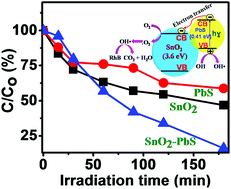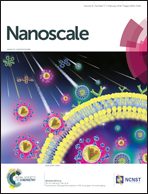Facile synthesis of SnO2–PbS nanocomposites with controlled structure for applications in photocatalysis†
Abstract
Recent studies have shown that SnO2-based nanocomposites offer excellent electrical, optical, and electrochemical properties. In this article, we present the facile and cost-effective fabrication, characterization and testing of a new SnO2–PbS nanocomposite photocatalyst designed to overcome low photocatalytic efficiency brought about by electron–hole recombination and narrow photoresponse range. The structure is fully elucidated by X-ray diffraction (XRD)/Reitveld refinement, Raman spectroscopy, X-ray photoelectron spectroscopy (XPS), Brunauer–Emmett–Teller (BET) surface area analysis, and transmission electron microscopy (TEM). Energy-dispersive X-ray spectroscopy (EDX) spectrum imaging analysis demonstrates the intermixing of SnO2 and PbS to form nanocomposites. A charge separation mechanism is presented that explains how the two semiconductors in junction function synergistically. The efficacy of this new nanocomposite material in the photocatalytic degradation of the toxic dye Rhodamine B under simulated solar irradiation is demonstrated. An apparent quantum yield of 0.217 mol min−1 W−1 is calculated with data revealing good catalyst recyclability and that charge separation in SnO2–PbS leads to significantly enhanced photocatalytic activity in comparison to either SnO2 or PbS.


 Please wait while we load your content...
Please wait while we load your content...